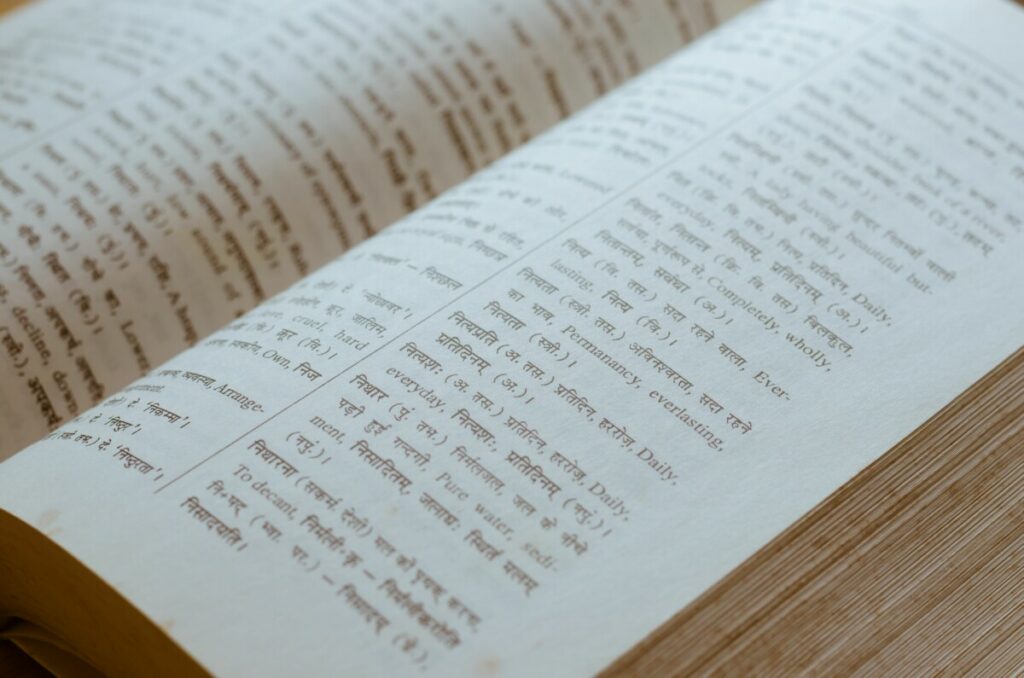
Throughout the world, there are a variety of languages spoken. In most countries, people speak a variety of languages and some even learn specific dialects to be able to communicate across cultures. In middle eastern countries, Hindi is one of the languages treasured and spoken, but should you learn how to speak Hindi??
Hindi is a language that can help people communicate throughout the majority of India. It also has many similarities to Urdu, which is spoken in many other countries and areas near India. This expands the usefulness of understanding Hindi. It is moderately difficult to learn, but not painfully hard.
With this general idea, there are many other concepts to consider. Some of the other facets to consider are what Hindi is, how useful the language is, how hard it is to learn, what resources are available, and tips for learning the language from Hindi-language speakers. We have that information below, so keep reading.
What is Hindi?
Hindi is the national language of India. It originally began in the northern region of India and has since developed and shifted as it spread throughout the rest of the country. People outside of the northern region of India do speak Hindi, but often times it is a second or third language. There are some other larger language groups in India as well, such as Manipuri, Bengali, and Marathi. Overall, 57% of the people in India speak Hindi.
Hindi is considered an Indo-European language like French, Spanish, and many other common languages. However, an important thing to understand is that the grammar, alphabet, and sounds are significantly different from other Indo-European languages.
Other languages that are close in vocabulary and grammar include Urdu and Sanskrit. Urdu and Hindi share a ton of words, but the higher and more formal levels of speaking Hindi have more in common with Sanskrit. There are also many different intonations and registers that Hindi is spoken in, so a person who is fluent in the language will often speak in a verbal way that is appropriate for the context.
How Useful is Hindi?

This question is a little trickier to answer, but statistics would suggest that learning Hindi can be an incredibly useful language. According to a 2022 study, Hindi is the fourth most spoken language in the world. According to the CIA in 2020, it is the third most spoken language in the world. In the CIA’s study, the number of people who spoke Hindi was even higher than the number of people who spoke Spanish, French, and many other staple languages that are considered highly useful in North America.
However, the usefulness of a language entirely depends on how a person intends on using it. If a person just wants to learn a language for the sake of curiosity or as a pastime, then it may not be entirely that useful in certain regions of the world. This is especially true for heavily populated areas that are dominated by other languages. However, if a person is learning Hindi in order to communicate with people who speak the language, to travel to India, or for a career, this language can be a helpful tool to have.
How Hard is Hindi to Learn?

One multilingual speaker described Hindi as harder to learn than Spanish but easier to learn than Arabic or Mandarin Chinese. This might be a hard comparison to understand, but there are many different facets of the language that explain why Hindi is considered a moderately difficult or hard language to learn as a second language. These facets include grammar, written language, sounds, and the social customs around phrasing.
The grammar surrounding Hindi is a special kind of difficult. As with many Indo-European languages, the language has masculine and feminine leanings attached to different words. This is new to native English speakers, but not uncommon for any multi-language speakers. Hindi has some additional tenses and new word types like postpositions that can also increase the level of difficulty in learning and understanding.
One of the biggest ways that Hindi differs from other Indo-European languages is the way sentences are structured. It is wildly different than English. For example, English has a structure that leans toward a sentence containing a subject followed by a verb followed by an object format.
Hindi follows a much different structure, where sentences are composed with a subject followed by an object followed by a verb. For example, when describing something that they like to do, an English speaker would say something like “I draw animals”. A Hindi speaker would say the same sentence as “I animals draw”. This can be an incredibly hard thing to master, especially as the language lacks many words that English speakers rely on, such as “a” and “the”.
On top of the prevalent issues with learning grammar, there is a whole other written alphabet that Hindi speakers use instead of the alphabet that is prevalent in English, Spanish, French, and other Indo-European languages. It is called a Devnagari script. Visually, it looks like many other languages with more of an image-like script. Luckily the language is phonetic, so once a person understands what the symbols represent the speaking portion comes more naturally.
The spoken aspects of the language can be rather complex due to the number of sounds involved. There are 33 consonants and 11 vowels in Hindi, which is much larger than the 21 consonants and 5 vowels in English. Beyond just the basic consonants and vowel sounds, the way the language is pronounced is much more complicated than it is in English. The way certain words in Hindi are pronounced entirely depends on how the air a person uses when speaking is released, as some sounds require a more delicate “ah” sound than a strong “a” sound. Tongue placement is also important to be aware of when trying to pronounce words accurately.
The final thing that can make Hindi a difficult language to learn is knowing the social cues and norms unique to the culture. Greetings are used differently and less frequently in Hindi than in English. People also refer to each other as family, even if they are not related. This is more a symbol of social class than literal relation.
Like with all languages, there is a culture and history attached that should be explored and understood. This is especially true if the learner is planning on using Hindi in an area that speaks mostly Hindi and very little English.
What Resources are Available to Learn Hindi?

There are not nearly as many resources to learn Hindi as there are for other languages like Spanish or French. However, there are still more Hindi resources available than there have been in previous years. To find good resources, a person has to do quite a bit of research. If a person knows where to look for good resources, they will find what they need.
Most of the traditional resources available are books, dictionaries, and native speakers or tutors. Some universities also offer Hindi classes. In the age of technology, there are now many additional resources available as well, such as online groups devoted to learning the language, apps built to help people learn reading and pronunciation skills, and a variety of websites to choose from. It’s important to understand what good resources are available for wannabe Hindi speakers.
Books
There are many books available, but one of the most highly recommended is called Teach Yourself Hindi by Robert Snell. It is probably one of the most commonly mentioned resources. He also wrote a book called Complete Hindi, which is also highly recommended, although some criticize the dialogue contained in its pages as being unrealistic.
Another book that is recommended is Elemental Hindi by Tuttle Publishing. This book is available with a corresponding workbook. It can be incredibly helpful to have something to work on after learning the principles. Elemental Hindi is also used at some colleges in their language classes.
Dictionaries
When it comes to dictionaries, there are quite a few options to choose from. Some people stick with the classic Oxford Hindi English Dictionary. The only downside is that it is a one-way translation. People who speak English and want to find a word in Hindi might struggle to find it.
Some people use the online version and search for an English word to overcome this obstacle. Another good dictionary is a mini dictionary made by Tuttle Publishing, which is a true two-way translation. English speakers might find this dictionary easier to use, as people can look up the English term to find the Hindi phrase.
Online Groups
The incredible thing about having the internet and new technology is the fact that people are able to connect and help each other learn new languages. There are many people trying to learn Hindi and they have banded together in many different groups and social media platforms. One person mentioned that there is a discord channel for people wanting to take an online class. This is one of the best ways to learn because a person will make connections to other people and feel accountable for showing up to the class prepared.
On other social media platforms like Reddit, there are entire pages of discussion dedicated to language learners. They have pages entirely used by Hindi speakers that people can go on and see the writing/script, test their ability to read and comprehend what they read, and ask questions. There are also pages entirely dedicated to language learners of all levels that can be useful tools.
Apps
There are several different apps people can use to enhance their language study. Some are very well known, such as Duolingo. Duolingo offers a basic platform for people who want a good foundation and encouragement for daily repetition.
Another app that native speakers especially appreciate is called Read Along. Read Along is an app produced by Google that gives people language feedback. How Read Along works is a person opens the app and selects a book to read. Most of the books available are children’s books.
The person then reads the book aloud and the app hears and gives a critique on the pronunciation. People can also click on the words to hear them spoken and discover definitions. People claim that this app helps them develop in ways that other resources don’t. The live feedback is probably the most incredible feature of this app and something people won’t get unless they go to a tutor.
Websites
There are many language-learning websites available for people to use. Websites that are highly acclaimed for their Hindi programs are Glossika and Clozemaster. Both of these programs are built to help people with repetition and consistent learning. There are many different website options.
If looking for a website, it is important to know that they are teaching a person the dialect of Hindi they want to learn and that the website is teaching them the language correctly. Pairing website use can help eliminate that concern.
Tips and Tricks to Learning Hindi from Hindi Speakers

The best way to learn a language is to immerse yourself in the language. This can be done in a variety of ways, including enjoying media, going to different locations, and speaking to natives.
One way that Hindi speakers recommend learning the language is by enjoying Hindi media. This can include podcasts, Bollywood movies, advertisements, and music videos. All of these help people see the language applied in realistic scenarios. It can help people learn the correct pronunciation and sentence structure, and help promote learning natural ways of speaking.
By watching people interact on TV in the language you are learning, you will be able to pick up some of the social cues and norms that many learners miss from just using a textbook and workbooks. They might also learn additional words and phrases that would not be covered in a textbook.
Another big way that Hindi speakers learn the language is by being around people who speak the language. Traveling to India and using the transportation systems in place is a huge opportunity to learn by example and experience. If someone really wants to be completely fluent, the best and fastest way is to go where a person’s native tongue is not the official language.
Learning Hindi is not for everyone. But for those who have a desire, it can be extremely rewarding. Hindi unlocks the opportunity to truly treasure unique cultures and experiences in another section of the world.
